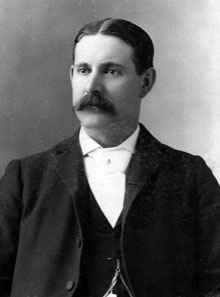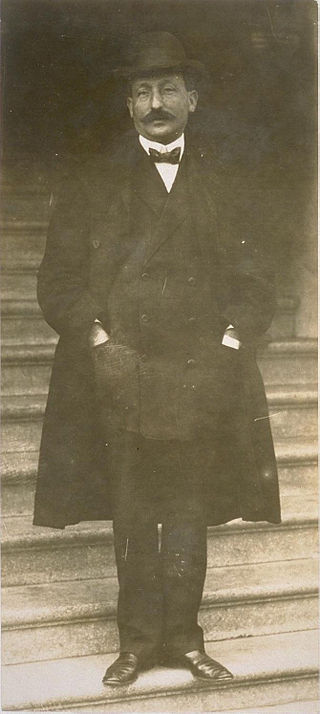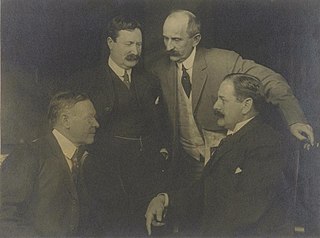
George Cooper Pardee was an American doctor of medicine and politician. As the 21st Governor of California, holding office from January 7, 1903, to January 9, 1907, Pardee was the second native-born Californian to assume the governorship, after Romualdo Pacheco, and the first governor born in California after statehood.

James Duval Phelan was an American politician, civic leader, and banker. He served as nonpartisan Mayor of San Francisco from 1897 to 1902. As mayor he advocated municipally run utilities and tried to protect his constituents from the monopolistic practices of the trusts. He represented California in the United States Senate from 1915 to 1921 as a Democrat. Phelan was a progressive supporter of the policies of Woodrow Wilson and was a leader in the movement to restrict Japanese and Chinese immigration to the United States.

The San Francisco Call ( Post ) was a newspaper that served San Francisco, California. Because of a succession of mergers with other newspapers, the paper variously came to be called The San Francisco Call & Post, the San Francisco Call-Bulletin, San Francisco News-Call Bulletin, and the News-Call Bulletin before the name was finally retired after the business was purchased by the San Francisco Examiner.

The mayor of the City and County of San Francisco is the head of the executive branch of the San Francisco city and county government. The officeholder has the duty to enforce city laws, and the power to either approve or veto bills passed by the San Francisco Board of Supervisors, the legislative branch. The mayor serves a four-year term and is limited to two successive terms. Because of San Francisco's status as a consolidated city-county, the mayor also serves as the head of government of the county; both entities have been governed together by a combined set of governing bodies since 1856.

The history of the city of San Francisco, California, and its development as a center of maritime trade, were shaped by its location at the entrance to a large natural harbor. San Francisco is the name of both the city and the county; the two share the same boundaries. Only lightly settled by European-Americans at first, after becoming the base for the gold rush of 1849 the city quickly became the largest and most important population, commercial, naval, and financial center in the American West. San Francisco was devastated by a great earthquake and fire in 1906 but was quickly rebuilt. The San Francisco Federal Reserve Branch opened in 1914, and the city continued to develop as a major business city throughout the first half of the 20th century. Starting in the later half of the 1960s, San Francisco became the city most famous for the hippie movement. In recent decades, San Francisco has become an important center of finance and technology. The high demand for housing, driven by its proximity to Silicon Valley, and the limited availability has led to the city being one of America's most expensive places to live. San Francisco is currently ranked 16th on the Global Financial Centres Index.

Tirey Lafayette Ford was an American lawyer and Republican politician who served as a California State Senator and the 18th Attorney-General of California. He acted as General Counsel for the United Railroads in San Francisco.

Eugene Edward Schmitz, often referenced as "Handsome Gene" Schmitz, was an American musician, musical director, and politician. He was the 26th Mayor of San Francisco, who was in office during the 1906 San Francisco earthquake.

Charles Boxton served as the 27th mayor of San Francisco for seven days, from July 9 to July 16, 1907.

Holy Cross Cemetery is a Roman Catholic cemetery in Colma, California, operated by the Archdiocese of San Francisco. Established in 1887 on 300 acres (1.2 km2), it is one of the oldest and largest cemeteries in California.

Abraham Ruef was an American lawyer and politician. He gained notoriety as the corrupt political boss behind the administration of Mayor Eugene Schmitz of San Francisco during the period before and after the 1906 San Francisco earthquake.

Francis Joseph Heney was an American lawyer, judge, and politician. Heney is known for killing an opposing plaintiff in self-defense and for being shot in the head by a prospective juror during the San Francisco graft trials. In 1891, while an attorney in Tucson, Arizona Territory, he defended the abused wife of John C. Handy. Handy attacked Heney, who shot and killed Handy. Heney later served as Attorney General of the Arizona Territory between 1893 and 1895. He was the chief prosecutor of the Oregon Land Fraud scandal from 1904 to 1910 and served as US District Attorney for the District of Oregon, from January 9 to December 3, 1905. He prosecuted corrupt San Francisco politicians, from 1906 to 1908.

The San Francisco Board of Supervisors is the legislative body of San Francisco, California, United States. The body consists of eleven members elected from single-member districts through ranked choice voting.

The 1908 New York state election was held on November 3, 1908, to elect the governor, the lieutenant governor, the Secretary of State, the state comptroller, the attorney general, the state treasurer, the state engineer and a judge of the New York Court of Appeals, as well as all members of the New York State Assembly and the New York State Senate.
William M. Malone (1900–1981) chaired the California Democratic Party during and after World War II. He was the most powerful Democratic Party leader of San Francisco during the later Roosevelt and Truman Administrations.

Henry J. Crocker was a prominent San Franciscan businessman, one of the Committee of Fifty formed after the 1906 San Francisco earthquake; he was also a noted philatelist.

The San Francisco graft trials were a series of attempts from 1905 to 1908 to prosecute members of the San Francisco Board of Supervisors, San Francisco Mayor Eugene Schmitz, attorney Abe Ruef, who were receiving bribes, and business owners who were paying the bribes. Political boss and attorney Ruef was at the center of the corruption, acting as attorney to Mayor Eugene Schmitz. He approved all contracts and received hundreds of thousands of dollars in payment from business owners, keeping a portion for himself and distributing the remainder to the Mayor and members of the Board of Supervisors.
Fairfax Henry Wheelan was an American businessman, philanthropist, and political reformer. As the chief complaining witness of voter fraud in 1904, he played a primary role in the eventual downfall of San Francisco Mayor Eugene Schmitz and his attorney and political boss Abe Ruef.















